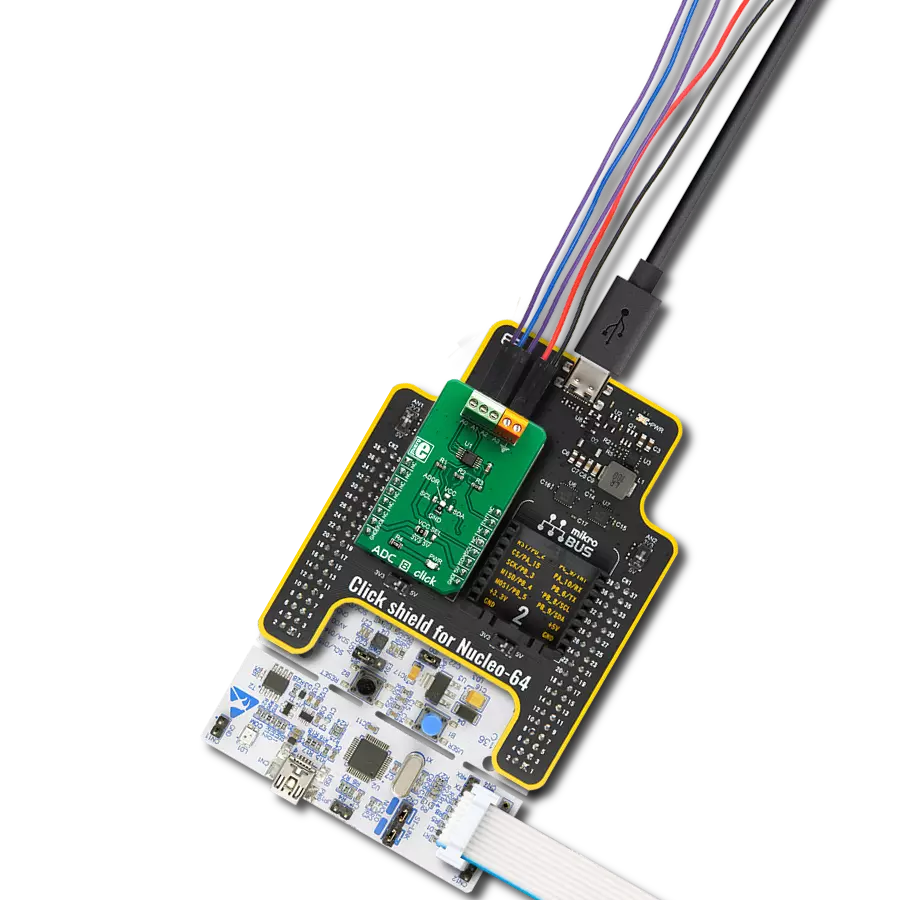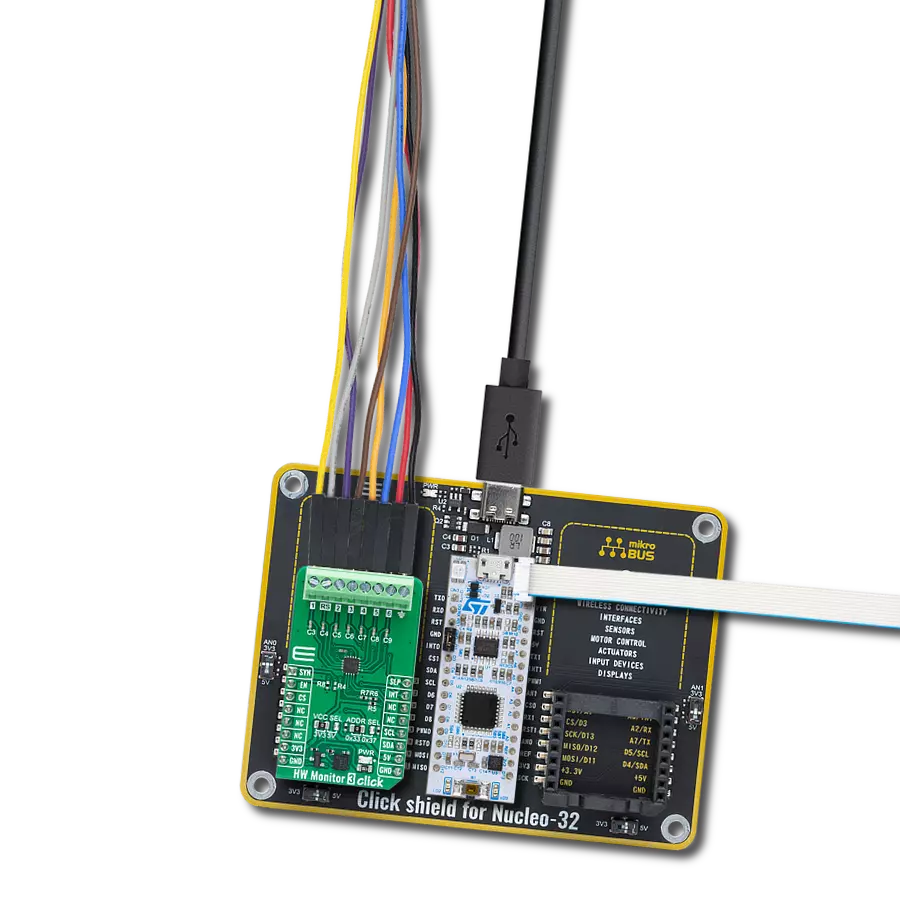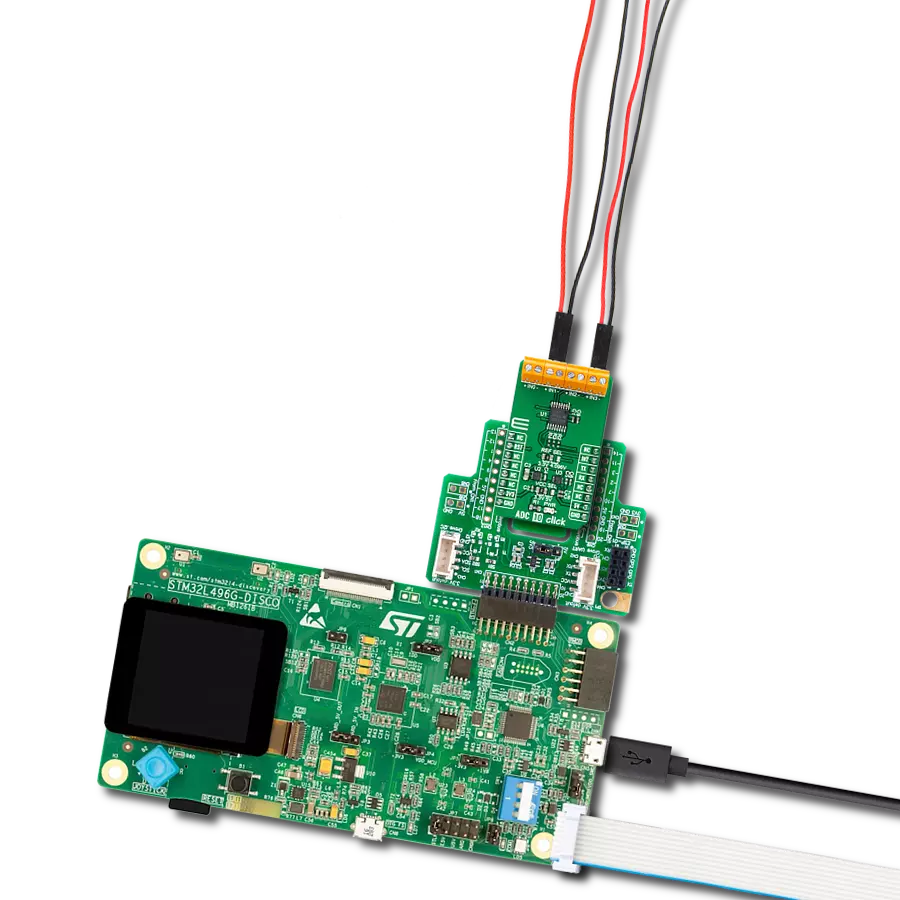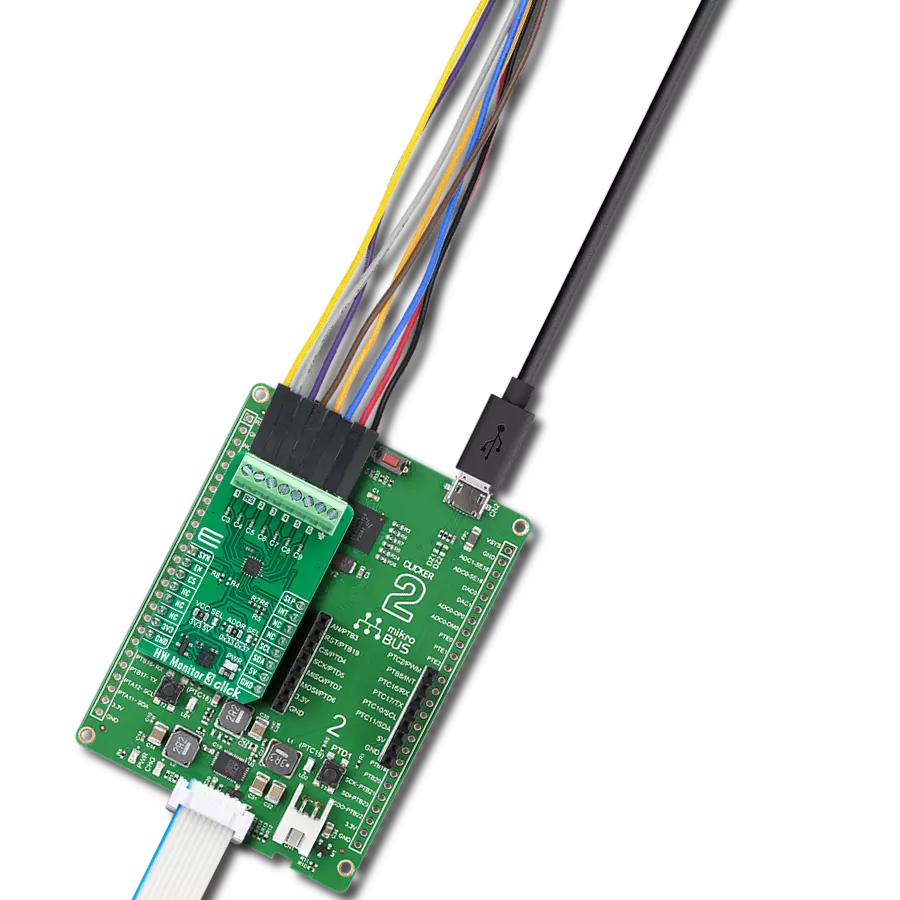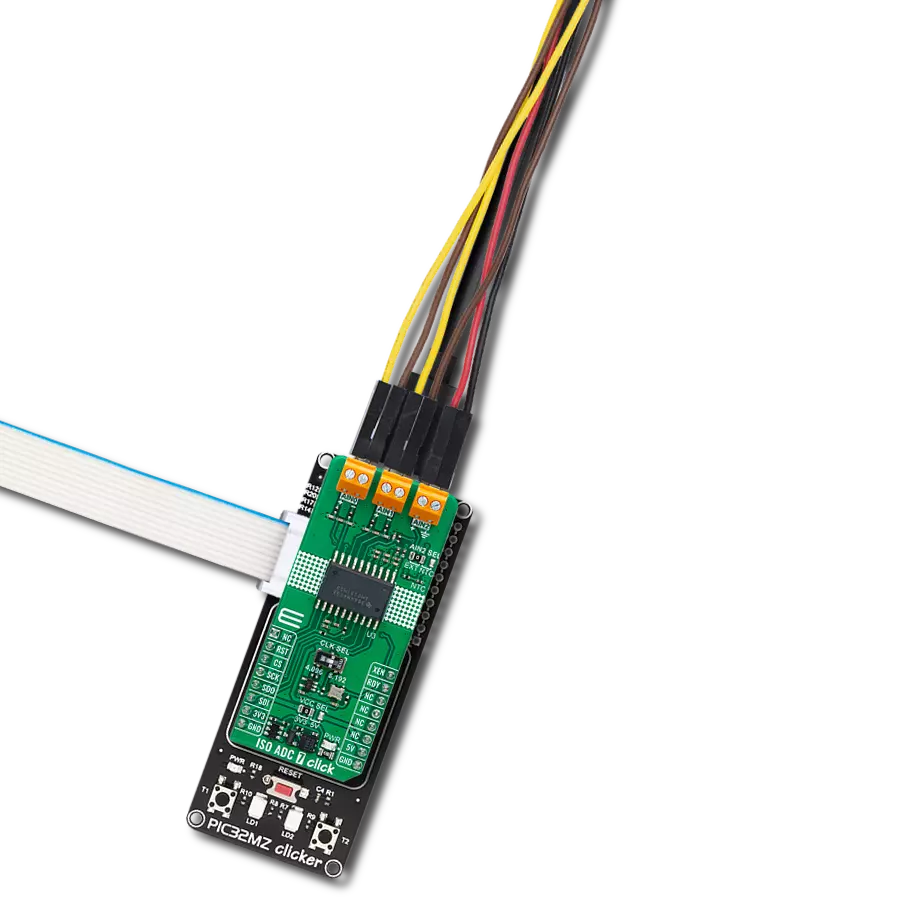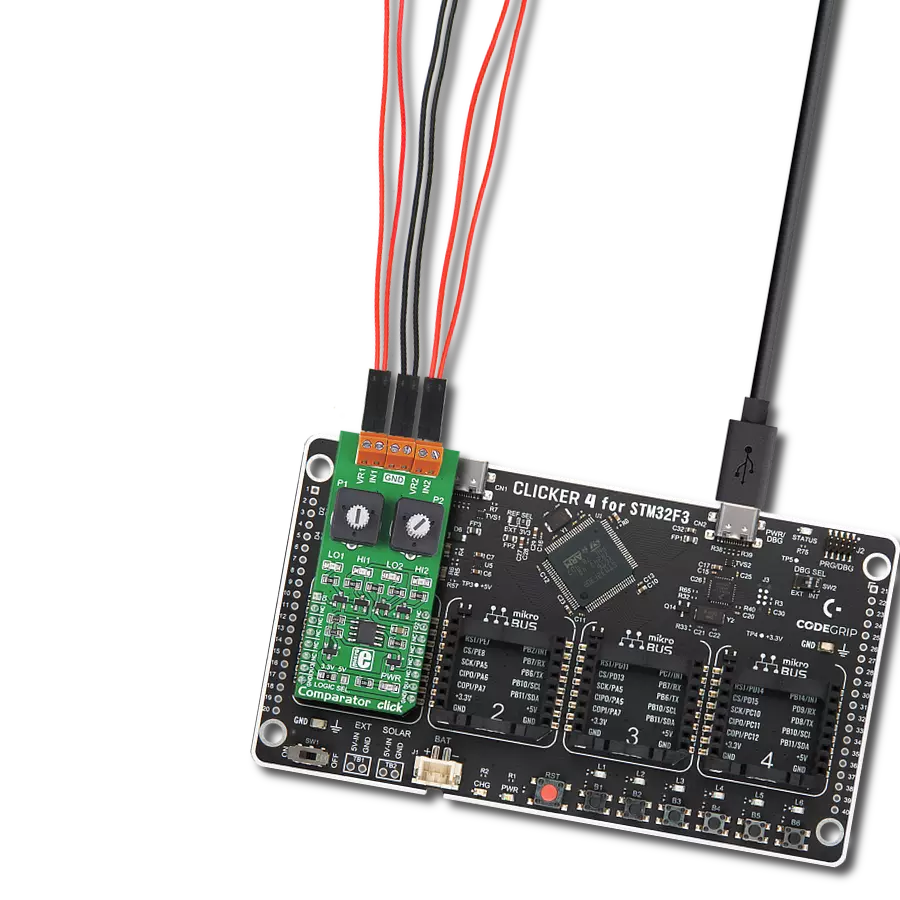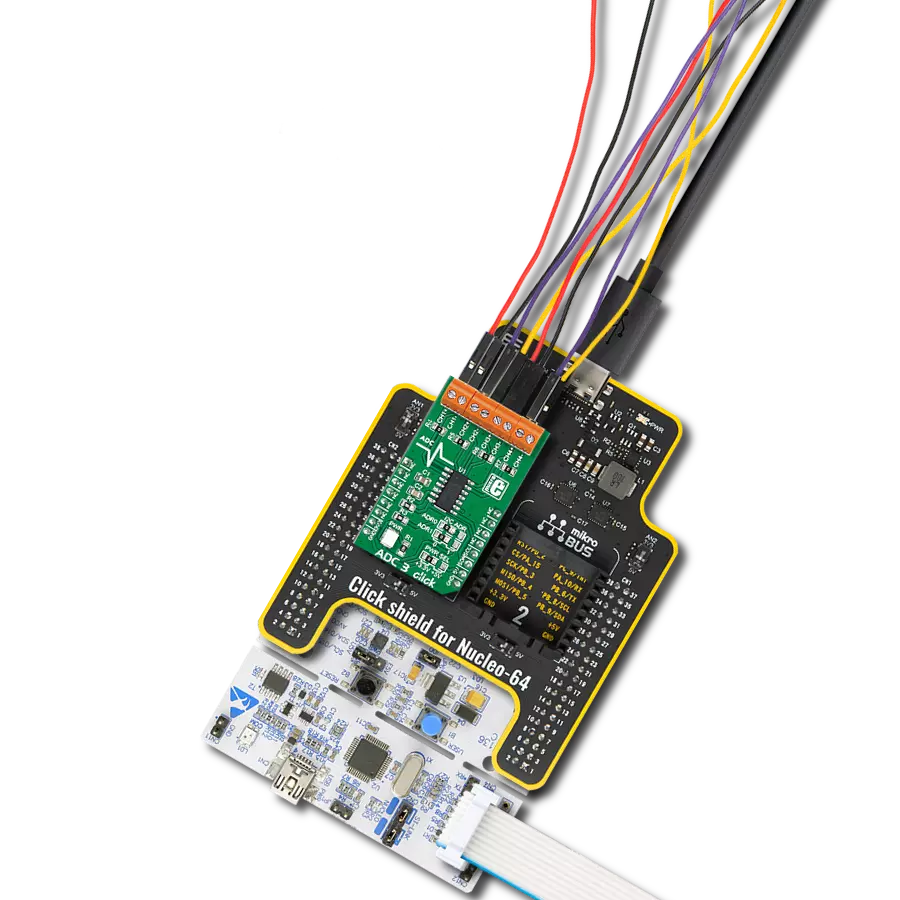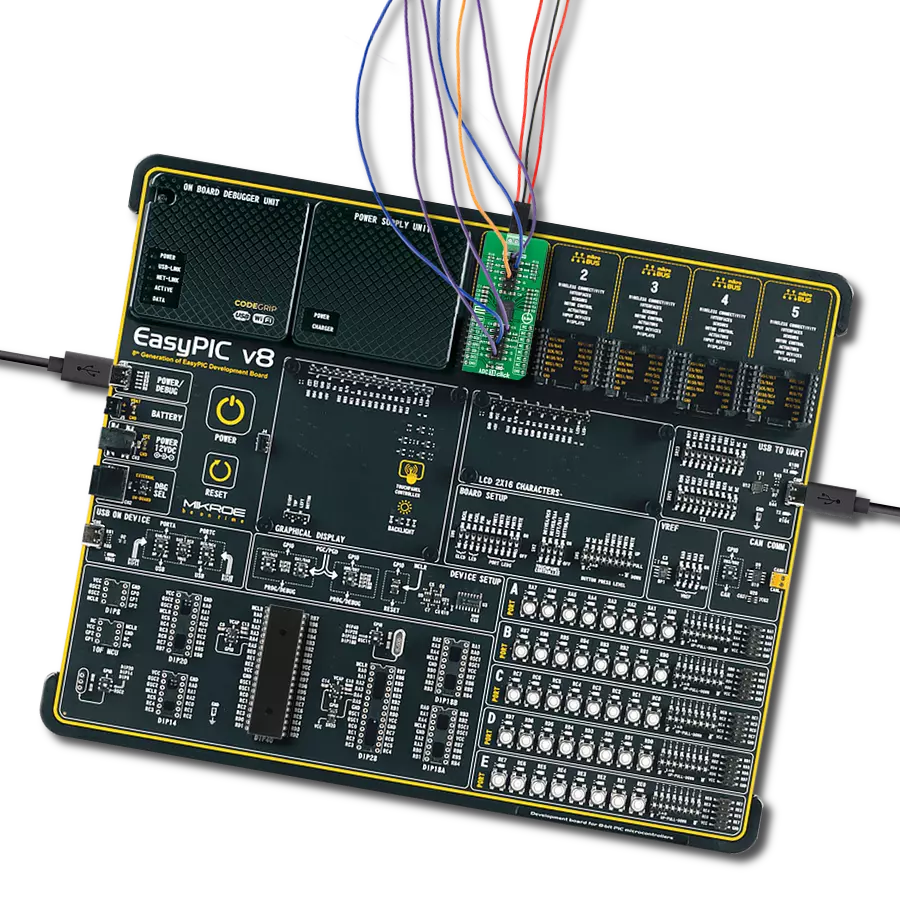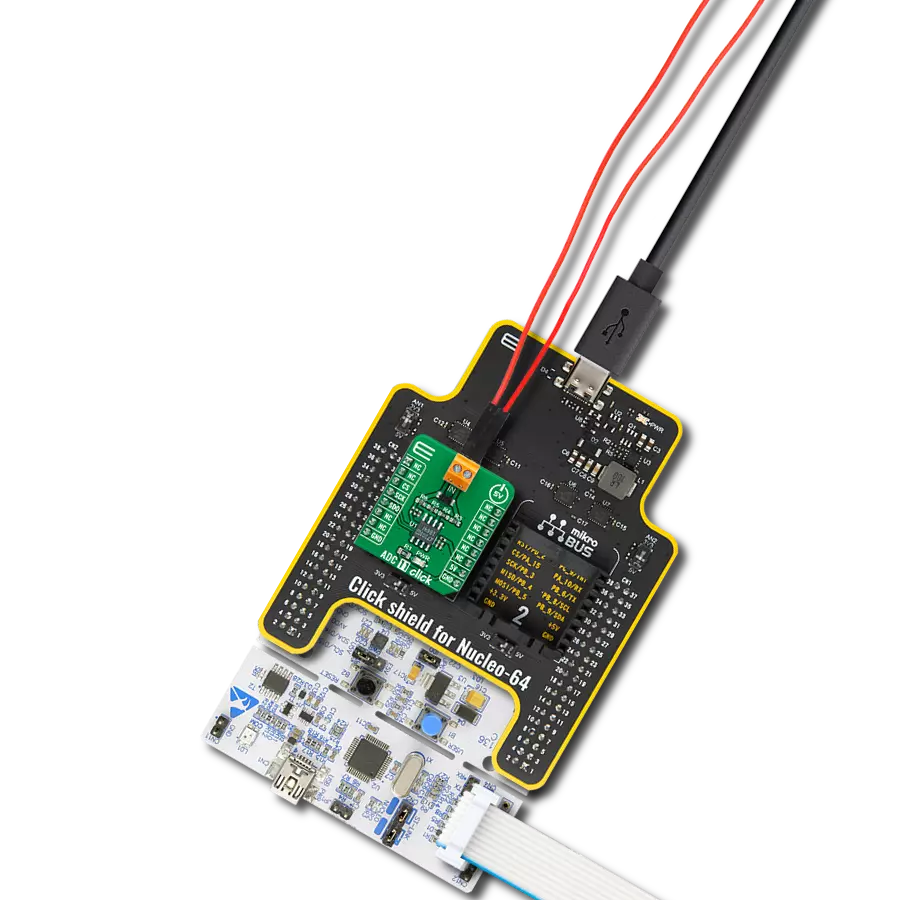Ready to take your designs to the next level? Our ADC can help – learn how!
A
A
Hardware Overview
How does it work?
ADC 11 Click is based on the LTC1864, a 16-bit successive approximation A/D converter with a sample-and-hold feature that operates on a single 5V supply from Analog Devices. The supply current, which can be only 850μA at 250ksps, drops at lower speeds because the LTC1864 automatically power-down between conversions. The high impedance analog input and the ability to operate with reduced spans down to 1V full scale allow direct connection to signal sources in many applications, eliminating the need for external gain stages.
Equipped with the 3-wire SPI serial interface and extremely high sample rate-to-power ratio, this Click board™ represents an ideal solution for compact, low-power, high-speed systems. ADC 11 click communicates with MCU through the simple 3-wire serial I/O compatible with industry-standard SPI interface. The LTC1864 has an internal conversion clock, so the clock rate does not affect the conversion. This fact allows the clock rate to run to 20MHz without concern for sample-and-hold droop at low clock frequencies or clocking the ADC too fast at high clock frequencies.
TThe data transfer requires only 16 clock cycles, minimizing the time necessary to transfer the data. The entire conversion can be transferred in only 800ns if the conversion clock runs at the maximum rate of 20MHz. This Click board™ can only be operated with a 5V logic voltage level. The board must perform appropriate logic voltage level conversion before using MCUs with different logic levels. However, the Click board™ comes equipped with a library containing functions and an example code that can be used as a reference for further development.
Features overview
Development board
PIC18F57Q43 Curiosity Nano evaluation kit is a cutting-edge hardware platform designed to evaluate microcontrollers within the PIC18-Q43 family. Central to its design is the inclusion of the powerful PIC18F57Q43 microcontroller (MCU), offering advanced functionalities and robust performance. Key features of this evaluation kit include a yellow user LED and a responsive
mechanical user switch, providing seamless interaction and testing. The provision for a 32.768kHz crystal footprint ensures precision timing capabilities. With an onboard debugger boasting a green power and status LED, programming and debugging become intuitive and efficient. Further enhancing its utility is the Virtual serial port (CDC) and a debug GPIO channel (DGI
GPIO), offering extensive connectivity options. Powered via USB, this kit boasts an adjustable target voltage feature facilitated by the MIC5353 LDO regulator, ensuring stable operation with an output voltage ranging from 1.8V to 5.1V, with a maximum output current of 500mA, subject to ambient temperature and voltage constraints.
Microcontroller Overview
MCU Card / MCU

Architecture
PIC
MCU Memory (KB)
128
Silicon Vendor
Microchip
Pin count
48
RAM (Bytes)
8196
You complete me!
Accessories
Curiosity Nano Base for Click boards is a versatile hardware extension platform created to streamline the integration between Curiosity Nano kits and extension boards, tailored explicitly for the mikroBUS™-standardized Click boards and Xplained Pro extension boards. This innovative base board (shield) offers seamless connectivity and expansion possibilities, simplifying experimentation and development. Key features include USB power compatibility from the Curiosity Nano kit, alongside an alternative external power input option for enhanced flexibility. The onboard Li-Ion/LiPo charger and management circuit ensure smooth operation for battery-powered applications, simplifying usage and management. Moreover, the base incorporates a fixed 3.3V PSU dedicated to target and mikroBUS™ power rails, alongside a fixed 5.0V boost converter catering to 5V power rails of mikroBUS™ sockets, providing stable power delivery for various connected devices.
Used MCU Pins
mikroBUS™ mapper
Take a closer look
Click board™ Schematic

Step by step
Project assembly
Track your results in real time
Application Output
1. Application Output - In Debug mode, the 'Application Output' window enables real-time data monitoring, offering direct insight into execution results. Ensure proper data display by configuring the environment correctly using the provided tutorial.

2. UART Terminal - Use the UART Terminal to monitor data transmission via a USB to UART converter, allowing direct communication between the Click board™ and your development system. Configure the baud rate and other serial settings according to your project's requirements to ensure proper functionality. For step-by-step setup instructions, refer to the provided tutorial.

3. Plot Output - The Plot feature offers a powerful way to visualize real-time sensor data, enabling trend analysis, debugging, and comparison of multiple data points. To set it up correctly, follow the provided tutorial, which includes a step-by-step example of using the Plot feature to display Click board™ readings. To use the Plot feature in your code, use the function: plot(*insert_graph_name*, variable_name);. This is a general format, and it is up to the user to replace 'insert_graph_name' with the actual graph name and 'variable_name' with the parameter to be displayed.

Software Support
Library Description
This library contains API for ADC 11 Click driver.
Key functions:
adc11_cfg_setup- Config Object Initialization function.adc11_init- Initialization function.adc11_default_cfg- Initialization function.
Open Source
Code example
The complete application code and a ready-to-use project are available through the NECTO Studio Package Manager for direct installation in the NECTO Studio. The application code can also be found on the MIKROE GitHub account.
/*!
* @file main.c
* @brief Adc11 Click example
*
* # Description
* This library contains API for ADC 11 Click driver.
* The library contains drivers for measuring ADC values
* and for calculation voltage.
*
* The demo application is composed of two sections :
*
* ## Application Init
* Initializes SPI driver and triggers the built-in calibration.
*
* ## Application Task
* This is an example that demonstrates the use of the ADC 11 Click board.
* In this example, we monitor and display voltage [ V ].
* Results are being sent to the Usart Terminal, where you can track their changes.
* All data logs write on USB UART changes every 2 sec.
*
* @author Nenad Filipovic
*
*/
#include "board.h"
#include "log.h"
#include "adc11.h"
static adc11_t adc11;
static log_t logger;
adc11_calibration_data_t avg_adc_data;
float voltage;
uint16_t adc_data;
void application_init ( void ) {
log_cfg_t log_cfg; /**< Logger config object. */
adc11_cfg_t adc11_cfg; /**< Click config object. */
/**
* Logger initialization.
* Default baud rate: 115200
* Default log level: LOG_LEVEL_DEBUG
* @note If USB_UART_RX and USB_UART_TX
* are defined as HAL_PIN_NC, you will
* need to define them manually for log to work.
* See @b LOG_MAP_USB_UART macro definition for detailed explanation.
*/
LOG_MAP_USB_UART( log_cfg );
log_init( &logger, &log_cfg );
// Click initialization.
adc11_cfg_setup( &adc11_cfg );
ADC11_MAP_MIKROBUS( adc11_cfg, MIKROBUS_1 );
err_t init_flag = adc11_init( &adc11, &adc11_cfg );
if ( init_flag == SPI_MASTER_ERROR ) {
log_error( &logger, " Application Init Error. " );
log_info( &logger, " Please, run program again... " );
for ( ; ; );
}
log_printf( &logger, "---------------------------\r\n");
log_printf( &logger, " Calibration \r\n");
log_printf( &logger, "- - - - - - - - - - - - - -\r\n");
log_printf( &logger, "> Turn OFF the Power unit <\r\n");
log_printf( &logger, "- - - - - - - - - - - - - -\r\n");
log_printf( &logger, " In the following 5 sec. \r\n");
log_printf( &logger, " turn OFF the Power Supply \r\n");
Delay_ms ( 1000 );
Delay_ms ( 1000 );
Delay_ms ( 1000 );
Delay_ms ( 1000 );
Delay_ms ( 1000 );
log_printf( &logger, "-------------------------\r\n");
log_printf( &logger, " Start calibration \r\n");
if ( adc11_set_calibration( &adc11, &avg_adc_data ) == ADC11_OK ) {
log_printf( &logger, "---------------------------\r\n");
log_printf( &logger, " Calibration Done \r\n");
Delay_ms ( 1000 );
}
log_printf( &logger, "---------------------------\r\n");
log_printf( &logger, " Start measurements : \r\n");
log_printf( &logger, "---------------------------\r\n");
}
void application_task ( void ) {
adc11_get_voltage( &adc11, &avg_adc_data, &voltage );
log_printf( &logger, " Volatge : %.3f V \r\n", voltage );
log_printf( &logger, "---------------------------\r\n");
Delay_ms ( 1000 );
Delay_ms ( 1000 );
}
int main ( void )
{
/* Do not remove this line or clock might not be set correctly. */
#ifdef PREINIT_SUPPORTED
preinit();
#endif
application_init( );
for ( ; ; )
{
application_task( );
}
return 0;
}
// ------------------------------------------------------------------------ END
Additional Support
Resources
Category:ADC























